RIBEIRA SACRA
What to do
San Pedro de Rocas Monastery and Ribeira Sacra Interpretation Center
Along the OU-536 road and before Esgos, in Tarreirigo we find a detour to the left signposted towards the monastery of San Pedro de Rocas, the oldest preserved hermit sanctuary in Galicia. by his side Ribeira Sacra Interpretation Centerwhere you can take a tour of the landscape, history, life, trades and traditions of the area.
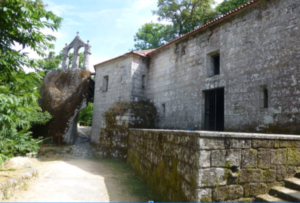
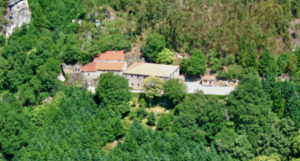
Royal Way
Next to the monastery is the Camino Real that goes to Esgos, a walk along it is not a bad idea, at least as far as the San Benito fountain.

Bambán do Solpor
We continue the tour along the same local road, passing through Loña do Monte and arriving in Luíntra, here is the collection point for the material for theescape room. to discover Ribeira Sacra in a fun way. The activity takes place entirely outside, making it ideal for families and groups of friends.
From here we head towards Santo Estevo along the OU-508 on the way to two stops, the first being “Bambán do Solpor” The swing, located near the Mámoas de Moura, although it is designed to watch the sunset, offers beautiful views all day long. And the second, the Os Penedos do Castro viewpoint, signposted on the left, without a doubt the best photo of the monastery.
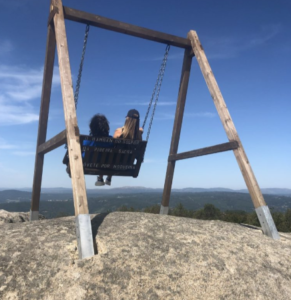
Santo Estevo de Ribas de Sil
We continue to Santo Estevo de Ribas de Sil former Benedictine monastery dating from the 6th century. It is the largest of the Ribeira Sacra monasteries, renovated for a national parador. In its environment interesting hiking trails.

Ribeira Sacra Catamaran
Shortly after leaving Santo Estevo, in the town of Loureiro there is the detour to the Santo Estevo pier where the Ribeira Sacra catamaran makes the itinerary along the river Sil. On the way down to the pier on the right, a sign indicates the viewpoint of Pena do Pobre, where the best bank in the Ribeira Sacra is located. (From there it is a distance of approximately 1km, but with a very hard climb. The best way to get to this viewpoint is from the town of Alberguería. You park in the vicinity of the cemetery and continue walking for about 2km. On the way before reaching Pena do Pobre we find the viewpoint of Pé do Home. To get to Alberguería, continue about 4km along the OU-0508 from Loureiro).


Monastery of Santa Cristina de Ribas do Sil
Along the same road we head to Parada do Sil, but not before stopping at theMirador de Cabezoas, one of the most impressive panoramic views of the Sil Canyons.
Arrived at Parada del Sil, at the beginning of the town there is a detour to the left that leads to the monastery of Santa Cristina de Ribas do Sil, located, without a doubt, in one of the most beautiful locations of the Ribeira Sacra, despite its semi-ruined state, it maintains its charm of a sacred place. On the way we can divert to O Castro viewpoint.

Balconies of Madrid
Back to Parada do Sil, we can see the monument to the waffle maker, or take a path that takes us to the balconies of Madrid, undoubtedly the best known viewpoints. Continuing with the discovery of these unique landscapes, an option to take into account is the Carriozas route. (2,5 Km. Circular.)
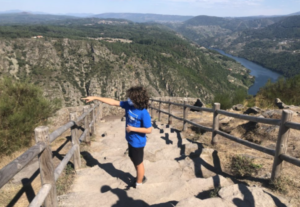

We must not leave Parada de Sil without approaching Teimende to the Museum of the Chocolate.

Necropolis of San Vitor de Barxacova
And we continue towards Teixeira along the OU-605, to approach the spectacular Mao River Route., a walk along the banks of this river along some wooden walkways that allow us to enjoy the landscape while we can expand our knowledge about the flora and fauna of the area. We can combine this walk with a visit to the necropolis of San Vítor de Barxacova, either following the hiking route or approaching the vicinity by car.


A Teixeira and Monastery of San Paio of Abeleda
We continue towards A Teixeira passing through Cristosende, with beautiful views over the Sil Canyon. From A Teixeira we will go down Lumeares and on the right we will find Fervenzas do Cachón (waterfalls) signposted. The route, about five hundred meters long and of low difficulty, makes it suitable for the whole family.
Along this same road we will find the monastery of San Paio de Abeleda, which despite its state of neglect, is a pleasant visit. If we continue towards Monforte we will find the A Abeleda pier, where we can catch one of the catamarans that travel along the Sil River.
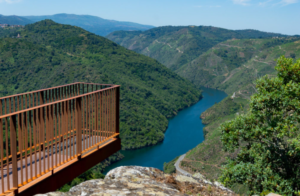
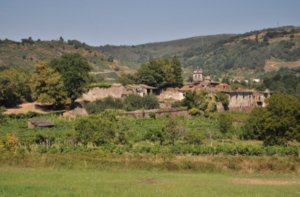
Visitable wine cellars
From here it is worth getting lost along the banks of the river to contemplate the impressive DO Ribeira Sacra wine terraces on the slopes or approach the spectacular viewpoint of As Penas de Matacás from the town of A Abeleda.
Heroic viticulture, this is how wine cultivation is known in the Ribeira Sacra. And it is that you have to be true heroes to cultivate the vineyards on the steep slopes of the Cañon do Sil. Check the visitable wineries.
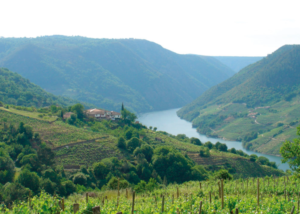
Castro Caldelas
We go up to Castro Caldelas which will be the next stop. In the center of the town we find its castle, although you can get there by car, we can leave the car in the Plaza del Prado and walk up through the old town. Inside the castle there is an interesting Ethnographic Museum. Don’t forget to try the typical dessert: la Bica.

It is also the starting point of a circular route “the magical forests” that takes you into the landscapes that surround Castro Caldelas. Enjoy walking through the natural and monumental heritage of what has recently been recognized as one of the most beautiful towns in Spain. We recommend that you take only the beautiful trail that leads to the Ponte das Táboas River Area. (total path is very long).
Santa Maria Monastery
We return to Ourense by the OU-536 we turn left to the town of Montederramo where we can visit the Monastery of Santa María. Founded in 1124 by Doña Teresa of Portugal. In the founding document, the first mention is made of the Rivoira Sacrata.
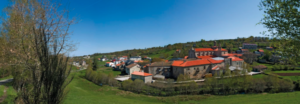
Bidueiral of Montederramo
If you want to do a hiking route, what better option than theBidueiral de Montederramo. A circular route of just over nine kilometers through this birch forest of great botanical importance, as it is one of the southernmost in Europe.

Xunqueira de Espadañedo
In Xunqueira de Espadanedo, its Romanesque church, the remains of the Renaissance monastery, and the Niñodaguia pottery center stand out. The Museum-Workshop is located in Niñodaguia, a typical pottery village, and in it we can take a trip to the heart of pottery and visit the old “fornos”.

We return to Ourense, with the satisfaction of having known the best of the Ribeira Sacra of Ourense. But do not hesitate to extend the route because many interesting places await you.











